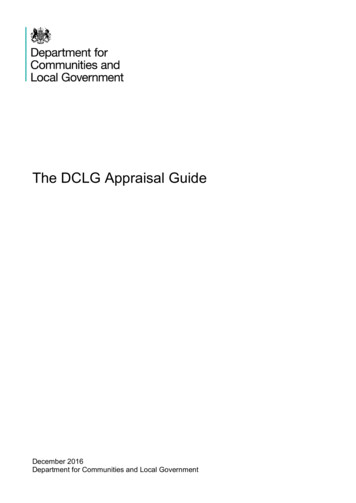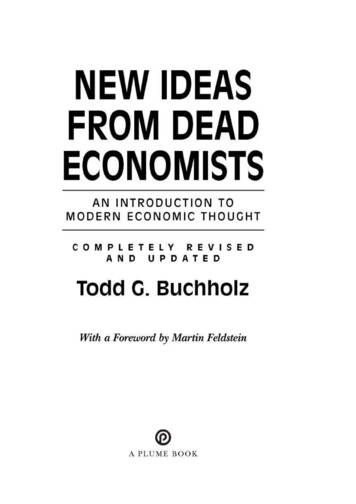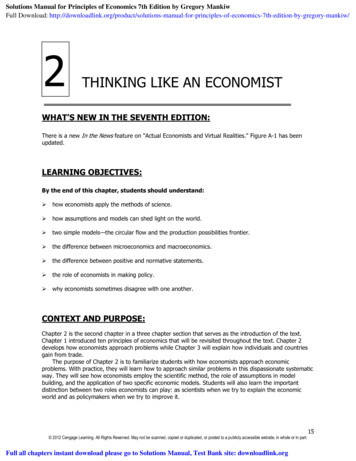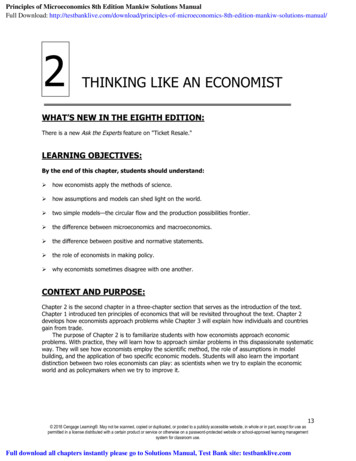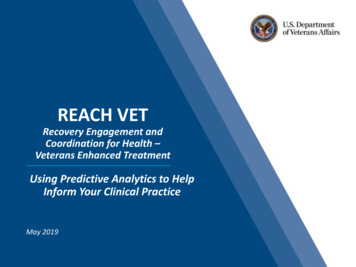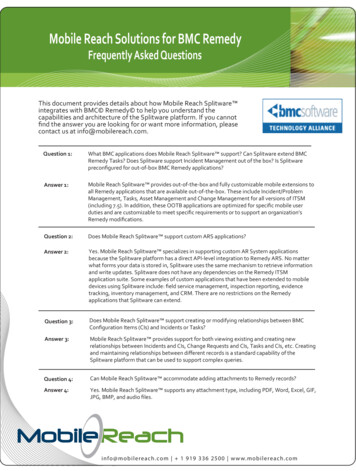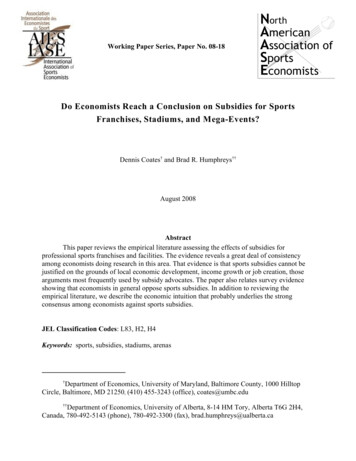
Transcription
Working Paper Series, Paper No. 08-18Do Economists Reach a Conclusion on Subsidies for SportsFranchises, Stadiums, and Mega-Events?Dennis Coates† and Brad R. Humphreys††August 2008AbstractThis paper reviews the empirical literature assessing the effects of subsidies forprofessional sports franchises and facilities. The evidence reveals a great deal of consistencyamong economists doing research in this area. That evidence is that sports subsidies cannot bejustified on the grounds of local economic development, income growth or job creation, thosearguments most frequently used by subsidy advocates. The paper also relates survey evidenceshowing that economists in general oppose sports subsidies. In addition to reviewing theempirical literature, we describe the economic intuition that probably underlies the strongconsensus among economists against sports subsidies.JEL Classification Codes: L83, H2, H4Keywords: sports, subsidies, stadiums, arenas†Department of Economics, University of Maryland, Baltimore County, 1000 HilltopCircle, Baltimore, MD 21250, (410) 455-3243 (office), coates@umbc.edu††Department of Economics, University of Alberta, 8-14 HM Tory, Alberta T6G 2H4,Canada, 780-492-5143 (phone), 780-492-3300 (fax), brad.humphreys@ualberta.ca
Do Economists Reach a Conclusion on Subsidies for Sports Franchises, Stadiums, andMega-Events? Dennis CoatesUniversity of Maryland, Baltimore CountyDepartment of Economics1000 Hilltop CircleBaltimore, MD 21250coates@umbc.eduBrad R. HumphreysUniversity of AlbertaDepartment of Economics8-14 HM ToryEdmonton, AlbertaT6G 2H4 Canadabrad.humphreys@ualberta.caAbstract: This paper reviews the empirical literature assessing the effects of subsidies forprofessional sports franchises and facilities. The evidence reveals a great deal ofconsistency among economists doing research in this area. That evidence is that sportssubsidies cannot be justified on the grounds of local economic development, incomegrowth or job creation, those arguments most frequently used by subsidy advocates. Thepaper also relates survey evidence showing that economists in general oppose sportssubsidies. In addition to reviewing the empirical literature, we describe the economicintuition that probably underlies the strong consensus among economists against sportssubsidies.Keywords: sports, subsidies, stadiums, arenasJEL codes: L83, H2, H4State and local governments in the United States have long been called upon to subsidizethe construction of stadiums and arenas. Indeed, the first wave of governmentsubsidization dates to the years between 1917 and 1926, the first boom in stadiumconstruction. Since then, one thing that has changed substantially is the rationale forpublic-sector support. In 1926, The Playground said the goal was for “the stadium tohave as broad a use as possible.” It recommended the once-familiar horseshoe shapebecause it facilitated egress via the open end and included a long straightaway suitablefor a procession. The implicit rationale was for the facility to serve the broad public1
interest by hosting pageants, parades, rallies, and festivals, as well as sporting contests ofall sorts from track and field to football and baseball. Today, stadium subsidizationfocuses on a single use, namely, hosting professional sports franchises, which usuallyhave substantial control over the facilities’ availability for other events.The change from public provision of venues available for a wide array of eventsto public subsidization of largely privately controlled facilities is a fairly recentphenomenon. The change occurred gradually. The first steps may have occurred withbaseball-franchise relocations –the Braves’ relocation in 1953 from Boston toMilwaukee, the Browns in 1954 from St. Louis to Baltimore, and the Athletics in 1955from Philadelphia to Kansas City. In each case, new or recently renovated publiclyowned facilities were made available to baseball franchises on quite generous terms. Forexample, The New York Times reported on March 15, 1953 that the Braves were offered aflat rental of 1,000 for the first two years on the new County Stadium in Milwaukee.1Ralph Wulz (1957) argued that public ownership of stadiums was justified if“private enterprise could not provide the service which the public demanded and at thesame time realize an adequate profit on its investment.” However, Wulz did not foreseeprivate businesses being subsidized in their use of these facilities, stating thatsubsidization might be suitable for “governmental activities and perhaps activities atwhich no admission is charged,” but that “commercial type activities pay the full cost ofthe services or facilities which are provided” (93).1It may be that what has come to be known as the major league city argument for attracting a professionalsports franchise came from Lou Perini, President of the Boston Braves, discussing his decision to move theteam to Milwaukee. The New York Times article quotes him as saying “Maybe Milwaukee isn’t a majorleague city. I don’t know, but I feel it will become one.”2
Wulz’s (1957) discussion raises the question of the possible theoreticaljustification for the subsidies we see today. Subsidies can, in general, be justified eitheron efficiency or distributive grounds. For example, a subsidy could be justified if theunsubsidized market would supply too little of the good. This is the classic situation ofpositive externalities. The subsidy would induce greater provision. Alternatively,subsidies could be justified as a means of redistribution. For example, public education ispaid for out of taxes, with wealthier individuals paying more in taxes than the cost of theservices they receive and poorer individuals paying less than the full cost of theeducation. We will address each of these justifications for stadium and arena subsidies inturn.To justify a stadium subsidy on efficiency grounds requires an explanation of howthe market outcome will result in “too little” quantity. That is, one must explain howmarginal social benefit from the stadium exceeds the marginal social cost. A difficulty inthis case is that sports facilities are very lumpy; the debate often focuses on building ornot building a facility, not about increasing the seating capacity by an additional seat.The market outcome, therefore, may be no construction of a stadium or an arena at all,and consequently no sporting events. This is the market failure justification implicit inthe “build it and they will come” strategy of cities whose intent is to lure an existingfranchise away from some other city or to induce a professional league to grant the cityan expansion franchise. It is also the justification for a city to replace an existing facilityto keep the current team or teams from moving.A recent example from the NBA illustrates the kind of thing that often goes onnow. The Seattle Supersonics were unhappy with their former home, KeyArena, and3
sought to have the city of Seattle build a new arena. Seattle refused and the teamexplored moving, which would require breaking their lease with the City of Seattle forKeyArena. A lawsuit ensued and they settled out of court, with the team moving toOklahoma City, for the 2008-2009 season, and paying Seattle tens of millions of dollarsto break the lease. Oklahoma City attracted the team by promising to spend 100 millionrenovating its existing arena to bring it up to current NBA standards and an additional 20 million to construct a practice facility. The existing arena in Oklahoma City was builtwithout an occupant during the 1990s as part of a downtown redevelopment plan. TheSeattle-Oklahoma City case suggests relevant lessons: Professional sports leagues areable to restrict entry and play one city off against another to extract the best subsidy deal.In doing so, there is a significant positional element—one city’s fan-base loses, anothergains. And teams exploit the cities where politics most effectively taps the taxpayers.In this paper we examine the economic research on subsidies for sportsfranchises, stadiums, and mega-events. We ask whether economists who conduct suchresearch reach a conclusion. Our investigation suggests that such economists largelyagree that subsidization is undesirable. Before turning to the economic literature, weexamine the results of a recent survey, and frame the issue in terms of economic intuition.4
The Average Economist Opposes Sports SubsidiesSurvey evidence indicates that on some policy issues economists in general holdviews different from those who specialize in the issue.2 When it comes to sportssubsidies, however, both sets of economists appear to agree. In a 2005 survey of arandom sample of American Economic Association members, Robert Whaples (2006)asked of agreement with the following:Local and state governments in the U.S. should eliminate subsidiesto professional sports franchises.Possible responses were “Strongly Disagree,” “Disagree,” “Neutral,” “Agree,” and“Strongly Agree.” Figure 1 shows that 58 percent strongly agreed, and 28 percent agreed.About 10 percent were “neutral.” Only 5 percent disagreed. Sports subsidies was but oneof about 20 policy issues included in the survey, but Whaples highlights this issue as oneof exceptional consensus—the other standouts being free trade, outsourcing, and theelimination of agricultural subsidies. The sports question, in fact, received the largest“strongly agree” response in the entire survey.2For example, on rail-transit projects and subsidies, Balaker and Kim (2006) show that the specialisteconomists are mostly opposed, likely much more so than the “average” economist; on the pharmaceuticalpolicies administered by the Food and Drug Administration, Klein (2008) indicates that the specialisteconomists are substantially more supportive of liberalization than the “average” economist.5
ResponseFigure 1: Economists' Responsesto Stadium Subsidy EliminationStrongly AgreeAgreeNeutralDisagreeStrongly Disagree0102030405060PercentSource: Whaples (2006)Incidentally, similar economic intuition can be attributed to Adam Smith (1776).In writing of “public diversions,” meaning displays “to amuse and divert the people bypainting, poetry, music, dancing; by all sorts of dramatic representations andexhibitions,” Smith favored the state’s “encouraging” such activities, but he specificallyclarified what he meant by “encouraging”: “that is by giving entire liberty to all thosewho for their own interest would attempt without scandal or indecency” (796). Thus,where Smith specifically identified the form of encouragement, he spoke of liberty andmade no mention of subsidization—whereas he did countenance subsidization when itcame to the schooling of children (785, 815).6
The Economic Intuition Behind the Case Against Sports SubsidiesThe consensus among economists on the question of sports facility subsidieslikely stems from the basic economic intuition that government subsidies ought toaddress some “market failure,” and economists sense that there is no compelling case tobe made for sports subsidies. The argument for a subsidy always comes from a localcontext, when a city wants to attract a new team or hold on to an existing one, and weaddress these local issues. But one can also assess the subsidy argument from a globalperspective, which is where we begin.The Seattle-Oklahoma City case described above is a perfect example of theglobal case against subsidies. Oklahoma City offered larger subsidies than Seattle waswilling to make, so the basketball franchise left Seattle for Oklahoma City. Basketballfans in Seattle lose, basketball fans in Oklahoma City gain. Perhaps there are more fansin Oklahoma City than in Seattle or fans in Oklahoma have more intense preferences forNBA basketball than fans in Seattle, so that there might be some slight gain in averagewelfare as a result of the franchise move. By and large, however, the franchise changingcities is a zero sum game for basketball fans. The team is enriched by the larger subsidyavailable in Oklahoma, but the move is clearly not a Pareto improvement in the allocationof resources. From a social perspective, a better approach to maximizing welfare mightbe for the NBA to expand the number of franchises so basketball fans across the countryhad their own local team to cheer. That, of course, is not in the best interests of thecurrent league members who derive substantial benefits, like the subsidies, from theirrestriction of supply.7
Calls for subsidies at the local level come from interest groups and theirconsulting firms—which we call “promoters” of subsidization—who talk up localbenefits of sports franchises, stadiums, and mega-events. As we shall see, promoters’claims of such local benefits don’t hold up empirically. But such rationales can also becountered by simple economic intuition.The promotional literature often suggests that if the city attracts or retains a sportsfranchise, its people derive specific economic benefits from the presence of the team,including more local jobs, higher local income, and increased local tax revenues. Inaddition, some promoters suggest that the presence of a franchise generates intangibleeconomic benefits for the city. For example, promoters consistently argue that havingmajor league sports raises the status of the city and brings added national and worldrecognition that enhances the business prospects and even the self-esteem of thecommunity. For example, Oklahoma City’s quest to raise the sales tax one cent to fundthe improvements to its existing arena went by the name “Big League City” campaign.The prospect of a game being broadcast nationally or even internationally from thestadium or arena is touted as a wonderful advertisement of the city’s virtues. Thesebenefits, which the teams cannot capture, are used to justify a local government subsidyfor the construction of the facility.The promotional literature suffers from a long list of methodological andtheoretical problems, all of which have been well-documented in the literature. Economicintuition suggests several of these problems:1. The redistributive implication of moving a franchise from one city to anotheralso applies to the context of moving a stadium from one part of a city to8
another. If a new stadium is built in the downtown area to revitalize thatsection of town, then at least a portion of any such vitality naturally comesfrom the part of the city around the original stadium.2. Sports is one of many cultural activities within the city. For every individualwho derives enjoyment from the presence of the sports franchises in thecommunity, there are likely to be other individuals who are uninterested insports or even resent being taxed to subsidize an activity they have no use for.Others argue that sports culture diverts people from more socially beneficialinterests and pursuits. Before accepting that sports teams generate externalbenefits, a careful and thorough look at “external costs,” and the alternativeuses of resources devoted to subsidies—uses that might also have “externalbenefits”—is clearly warranted. Unfortunately, such debate quickly leadspublic discourse and policymakers into a briar patch of unpriced values thatare easily misrepresented. Thus, economists generally urge that society steeraway from government sponsorship of cultural activities not related toeducation.3. Government expenditures on stadium and arena subsidies carry opportunitycosts which are never addressed. Tax collections used to pay stadium debt,for example, could have gone for other public projects with higher social ratesof return than a stadium. One never knows what the returns to alternative usesof the funds might be because alternatives are never discussed. Thesealternative uses could be construction or maintenance projects, on highways,9
mass transit systems, hospitals, or schools. Or, the alternative could be toreduce taxes.4. Whatever inefficiencies might exist in a system without sports subsidies,economic intuition suggests that government subsidization introduces newdistortions and imperfections, including the excess burden and administrativecosts of raising and spending tax monies.The Whaples survey did not ask economists the reasons for their views, so wecannot say that the foregoing points speak for economists in general. It seems clearenough, though, that economists are unlikely to warm to subsidies that do not plausiblyfoster a public good or serve redistributive goals. The case for sports subsides is weak,prima facie. Further, sports subsidies do not do much to advance political identity, as it isnot the polity but the sport, the league, the team and their multi-million dollar players andmanagers who soak up the attention and identification. It is plausible, for example, thatsome economists warm to rail-transit projects and subsidies for their political andsymbolic aspects, but sports subsidies lack even this “benefit.”Despite the strong intuitive case against stadium and arena subsidies, they existand are valued in the billions of dollars. The local promoters have claimed millions ofdollars in benefits to the community and, apparently, their arguments have provenconvincing. We turn now to the evidence on the local benefits from those subsidies.10
The Promotional Literature Versus the EconomistsThe remainder of this paper surveys the literature on the subsidization of sportsfranchises through the provision of publicly financed stadiums and arenas to determinewhether economists reach a conclusion on the efficacy of those subsidies as sources ofeconomic development, income and tax revenue growth and job creation. This literatureconsists of two rather distinct types of analysis: analysis done largely by academics,mostly economists, but also regional scientists, urban affairs, and public policy scholars;and analysis done by consulting firms who may employ economists, accountants, orpolicy analysts. Work by this latter group is what we have referred to as the promotionalliterature.Within the promotional literature, proponents of stadium subsidies argue thatsubsidies are warranted because of the local economic development benefits of building astadium or arena, including the “big league city” benefits. They do not support subsidiesbased on the consumer surplus derived by game attendance nor from consumer externalbenefits from such activities as talking about the teams or following them through theprint or broadcast media. The economic development benefits of interest to boosters arepredominantly identified with income and job creation, and sometimes as increased taxrevenue, and are generally called “tangible benefits” in the literature. Because theproponents of stadium subsidies focus on jobs, income, and tax revenue enhancement, theacademic literature has focused its attention on these purported benefits as well untilquite recently.11
Some subsidy advocates have implicitly justified them as enhancingredistribution. This justification exists both in the promotional “economic impact”literature and in the academic literature, with most examples of the latter appearingrecently. The justification is that building stadiums or arenas downtown, in the centralcity of metropolitan areas, will bring economic activity to those neighborhoods and aid intheir revitalization. Downtown areas, especially in older cities, have become stagnantand decayed over time as people and businesses moved to the suburbs. Those older areasare, so the argument goes, deserving of assistance, even at the expense of the outlyingareas. This justification rests on the downtown stadium or arena bringing new jobs andbusinesses into the downtown area.We restrict our attention to the academic literature, much of which attempts toverify the claims of the promotional literature. Because several contributors to theliterature do not hold a Ph.D. in economics, we have tried to distinguish “non-economist”authors from authors who are economists. A necessary condition for being classified asnon-economist is not holding a Ph. D. in economics. Absent information on thediscipline of an author’s doctorate, we also report in footnotes whether the author inquestion does not work or has not worked in economics departments, and if one does notpublish predominantly in economics journals. The individuals who either do not hold adoctorate in economics or have not worked in economics departments or whose researchis published primarily in public policy or urban or regional science journals tend to reachconclusions generally at odds with “economist” authors—that is, those that hold adoctorate in economics, work or have worked primarily in economics departments, orpublish predominantly in economics journals.12
The literature initially examined data on local or regional output, income, and jobsfor evidence of an impact from sports franchises and facilities. More recently, the searchfor economic effects of franchises and facilities has turned to tax revenues and to effectson rents and property values. Researchers have looked for evidence of economic impactflowing from the operation of sports facilities and from the construction of thesefacilities. In addition, we address the extent to which subsidies to sports franchises andfacilities are connected to the city being selected as host for a sporting mega-event, suchas the Super Bowl or the Major League Baseball All-Star Game, and estimates of thesubsequent benefits to the city from hosting these events.Both academic economists and consultants reach a conclusion about the economicimpact of professional sports franchises and facilities, but these two groups reachopposite conclusions. The clear consensus among academic economists is thatprofessional sports franchises and facilities generate no “tangible” economic impacts interms of income or job creation and are not, therefore, powerful instruments for fosteringlocal economic development. The clear consensus among consultants who produce“economic impact studies” is that professional sports franchises and facilities generatesizable job creation, incremental income increases, and additional tax revenues for stateand local governments. We will not discuss further the promotional economic impactstudies but instead refer the reader to four excellent criticisms of those studies, namely,Noll and Zimbalist (1997c), Crompton (1995), Siegfried and Zimbalist (2000), andHudson (2001). In particular, the book Sports, Jobs and Taxes: The Economic Impact ofSports Teams and Stadiums by Roger Noll and Andrew Zimbalist (1997a) broughttogether a series of papers that addressed teams and stadiums as economic development13
tools. The title of their introductory chapter, “Build the Stadium – Create the Jobs!”(1997b), indicates just how far the thinking about sports facilities has changed since the1920s. Since the publication of Sports, Jobs and Taxes, a large literature has developedassessing the impact of stadiums and franchises on city economies.Here, we review the existing literature on the tangible economic impact ofprofessional sports franchises and facilities published in peer reviewed journals.Although a small and growing literature exists which estimates the value of “intangible”economic benefits, we do not survey this literature.The Findings of Peer-Reviewed Economic Research on Economic ImpactsThe academic research on the economic impact of professional sports franchisesand facilities, in general, comes from retrospective econometric research, though somecase studies also exist. In the econometric research, researchers collect time series orpanel data from Metropolitan Areas (MAs) or states that were home to professionalsports franchises and facilities and estimate reduced form econometric models of thedetermination of various economic indicators, typically real income per capita or totalemployment. These analyses generate estimates of the impact of a sports franchise orfacility on the economy. If the coefficient on a facility or franchise variable isstatistically significant and positive, then statistically that sports variable is inferred toinduce an increase in the dependent variable measuring economic activity. If the sportsvariable is not statistically significant or is significant and negative, then the inference isthat the variable does not induce increases in economic activity or that it causes a decline14
in activity. When the variable is positive and statistically significant, the coefficient isassessed for economic significance by the researcher and compared to the claims ofsports boosters. For example, boosters may claim that hosting the Super Bowl willgenerate 300 million of new income, but the estimates associate the Super Bowl withonly 30 million dollars of activity. Academic economists interpret disparities betweenboosters’ findings and independent researchers’ results as evidence that sports leddevelopment is not efficacious.Professional Sports Franchises and FacilitiesThere now exists almost twenty years of research on the economic impact ofprofessional sports franchises and facilities on the local economy. The results in thisliterature are strikingly consistent. No matter what cities or geographical areas areexamined, no matter what estimators are used, no matter what model specifications areused, and no matter what variables are used, articles published in peer reviewedeconomics journals contain almost no evidence that professional sports franchises andfacilities have a measurable economic impact on the economy.Baade and Dye (1988) examined the economic impact of professional sports onthe determination of annual manufacturing employment, real value added inmanufacturing, and new capital expenditure by manufacturing firms in eight metropolitanareas over the period 1965-1978. The source of their data was the Annual Survey ofManufacturers. Explanatory variables included the population of the metropolitan area(MA), a time trend, and indicators for a new or renovated stadium, a professional footballfranchise, and a professional baseball franchise. They found little evidence that variation15
in professional sports franchises or facilities explained observed variation in employment,value added, or capital expenditure. Only four of the parameters on the franchise/facilityindicators were statistically significant at the 5% level; three were positive and one wasnegative. Interestingly, this is the only paper in the literature to make use of MA datafrom the Annual Survey of Manufacturers. This survey contains detailed MA level dataon the composition of businesses in the local economy and should be used more oftenwhen assessing the economic impact of professional sports.Baade and Dye (1990) next examined the economic impact of professional sportson annual real MA personal income, and the ratio of MA personal income to regionalpersonal income in nine MAs over the period 1965-1983. The explanatory variableswere the same as in their earlier study and they found no evidence that variation in thepresence of sports franchises and facilities explained any of the variation in the realpersonal income across MAs.Baade (1996) examined the economic impact of professional sports on thedetermination of real per capita income and the metropolitan area’s share of stateemployment in the Amusement and Recreation industry and the Commercial Sportsindustry in 48 metropolitan areas over the period 1957-1989. The dependent variable,real per capita income, in these reduced form regression models was transformed using acomplex function of the average level of per capita income across the cities in the sampleand first differences. The 48 metropolitan areas in the sample included both cities withprofessional sports teams and cities with no professional sports teams. Separateregressions were run for each metropolitan area. The explanatory variables included thenumber of sports franchises and the number of sports facilities less than ten years old in16
the metropolitan area. In general, the sports facility and franchise variables were notstatistically significant, and the few that were significant displayed no consistent patternof signs. Baade (1996) concluded that there was no evidence that professional sportsfranchises or facilities had a positive impact on real per capita income or employment inthese two industry classifications that include sports franchises.Baade and Sanderson (1997) examined the employment created by sportsfacilities. The authors used data on employment from the Amusements and Recreation,and Commercial Sports Industry classifications of the Standard Industrial Classificationfor ten cities and their states covering the years 1958 through 1993. They estimatedseparate regressions for each city, with the dependent variable either the city’s share ofstate employment in the Amusements and Recreation or the city’s share of stateemployment in Commercial Sports. They found very little effect of newly constructedstadiums or from having additional professional teams on employment shares. Whennew stadiums were significant, their effect was to reduce the city’s share of employment.An additional team statistically significantly raised the city’s share in several cases, andreduced it significantly in one case. Thirteen of twenty coefficients for the number ofteams were not statistically significant. Baade and Sanderson sum up their results bysaying, “In general, the results of this study do not support a positive correlation betweenprofessional sports and job creation” (112).Hudson (1999) examined the economic impact of professional sports on urbanemployment in 17 metropolitan areas over a twenty year period. This study used both thenumber of professional sports franchises in the metropolitan area and indicator variablesfor the presence of MLB, NFL, NBA and NHL franchises, as well as a variety of17
explanatory variables reflecting loca
of exceptional consensus—the other standouts being free trade, outsourcing, and the elimination of agricultural subsidies. The sports question, in fact, received the largest "strongly agree" response in the entire survey. 2 For example, on rail-transit projects and subsidies, Balaker and Kim (2006) show that the specialist

